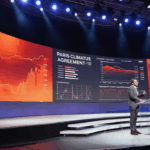Concerns as to the ultimate efficacy of net zero targets are fully justified. Combining near-term action with accountability against commitments to fulfilling the Paris Agreement demand companies and investors commit to intermediate target for 2030 or sooner. They must do so by using robust, science-based guidelines. In this piece, Ksapa considers to what extent Net Zero approaches can be a credible lever to build carbon-constrained economies.
Net Zero Pledges: the New Normal?
Key Players Are Now On Board
In April 2021, the latest industry-led and UN-convened Net-Zero Banking Alliance brought together 43 banks from 23 countries with US$28.5 trillion in assets. Together, they committed to align their lending and investment portfolios with a net-zero emissions goal by 2050. This is just another of many Net Zero initiatives issued in the past two years. Federal and state governments in the US have various long-term net zero emissions commitments. Around two thirds of the global GDP are now covered by targets of some sort.
Businesses and investors swiftly followed suit. Over 2,100 of the world’s largest corporates have Net Zero goals under the UN-backed Race to Zero campaign. Meanwhile, asset managers and owners worth trillions of dollars pledged to deliver Net Zero emission portfolios before 2050. These goals helped trigger billions of dollars of investment in low carbon infrastructure and innovation. It also enabled an entire new ecosystem of activists, academics, regulators, investors, politicians and business executives working round the clock to translate long-term net zero ambitions into credible near-term decarbonization strategies.
Sound Reasons for Hope
Following the Paris Agreement, scientists mainstreamed the notion we should strive not just for a 2°C global warming scenario, but set our sights on 1,5°C. That way, we would collectively “achieve a balance between anthropogenic emissions by sources and removals by sinks of greenhouse gases in the second half of this century“. These goals eventually unleashed one of the fastest and most consequential corporate trends since the first Industrial Revolution.
The Biden Administration is well on its way to develop “jobs, jobs, jobs” for the American worker. The fact its approach onboards climate is the ultimate victory for one of the most successful environmental campaigns in history.
Fierce Criticism From Climate Activists
A growing number of influential climate activists and scientists have however shared strong criticism of these Net Zero approaches.
Net Zero (Really) is Not Zero
Not a day goes by where my Twitter account does not showcase new blicking Net Zero commitments. A trend systematically met with a onslaught of criticism. But why do climate activists equate so many net zero commitments to greenwashing? Just what does “real zero” really mean?
For Greta Thunberg, “net zero targets” are “being used as excuses to postpone real action“.
The Proof Is in the Pudding
Much of the criticism around Net Zero strategies is entirely justified, for at least 3 reasons:
1. Climate Science is Cristal Clear
We need our economies to become “net zero” well before 2050. That turning point must be secured between 2030 and 2035 to significantly curb GHG emissions and stay as close as possible to a 1,5°C global warming trajectory. In that regard, the Paris Agreement was a diplomatic process, which settled on the year 2050 to placate all stakeholders.
Six years after the historic COP21, we are closer to a 3°C global warming trajectory. As such, any Net Zero target that does not contribute to this momentous drive in the coming decade is downright misleading.
2. Accountability and Putting Skin in the Game Matter
Most decision-makers who issue 2040 pledges today will doubtlessly have retired by then.
Working closely with various Fortune 500 business and large investors on their climate strategies, Ksapa cannot emphasize enough how little we know about the technologies or mergers/acquisitions that will frame our collective climate environment beyond the next 5 years.
The publishing business, for instance, heavily invested in decarbonizing printing factories as early as the 2010’s. The following decade saw a majority of business-themed books turn massively to e-book format. Sure, the resulting carbon footprint changed dramatically: it was transfered from printers to servers.
3. The devil is in the detail
There can be no sound Net Zero strategy that does not work hard to decouple the underpinning business and value creation models from resources consumption in an increasingly climate-constrained world. Should Net Zero strategies avoid difficult choices and leave radical transformations up to the next generation of decision-makers, then they to not serve their company. Much less the climate cause.
Moving Targets All Too Often Backed By Weak Strategies
Criticisms generally point to the concern Net Zero strategies are only designed to perpetuate business as usual. In other words, that they issued tepid targets and poorly defined pathways, without offering greater clarity as to what needs to be done to acheive net neutrality and when. After all, Germany unilateraly decided in May 2021 to move its net zero roadmap forward to 2045. That is no less than 5 years ahead of the European Union’s declared target.
Such decisions lend themselves to another veine of criticism, given moving targets hurt the robustness of the overarching net neutrality plans. The likes of Carbon Tracker and CDP have repeatedly criticized many of the world’s leading carbon-intensive corporations and investors’ Net Zero pledges. Deeply flawed, they are indeed not backed by credible strategies to wind down our fossil fuel infrastructure. Nor do they pivot towards clean technologies fast enough.
Upholding Credible Net Zero Approaches
That said, there are 3 good reasons why we should not throw the baby out with the bath water.
- Inertia. Anyone (like myself) who will have spent a significant amount of time working alongside large industrial facilities can understand they cannot just switch and decabornize within a few months. The idea they can may sound great, but in actuality, key activities need time to absorb transformations.
- Cognitive Dissonance. Let’s all remember we all lead carbon-intensive lives. It is easy enough to blame carbon emitters. The truth is we can (and should) all work towards carbon neutrality. At least, the private sector is issuing public commitments in this space.
- Internal alignment. Net Zero strategies entail a journey more than anything else. Moving targets and insufficient strategies are not necessarily a problem so long as companies commit to explore, implement, learn and improve. The more climate strategies are submitted to a process of trial-and-error and continuous learning, the more attuned they will be to the pressures of their immediate environment. Only then may they accelerate progress against their Net Zero goals.
Net Zero Might Just Be The Start
The architects of the Paris Agreement and the numerous businesses around the world striving to transform themselves have been working hard to develop a constructive framework. They have in fact enabled stakeholders to understand how to make progress towards fully decarbonized operations and be mindful of uncertainties and resistances along the way.
The bulk of the global auto industry has, for instance, publicly committed to electrifying their products. Renewables are the default source of energy in a majority of markets around the world. National climate laws are increasing pressure across markets. Prior to the Covid-19 crisis, teenagers would take their demands for climate action to the streets every friday. Billions of liquidities are flowing to support innovation and decarbonize infrastructures across the US and Europe.
Net Zero is merely a drop in a ncessarily larger sea of change.
Trusting the Science Behind Net Zero Strategies
Net Zero approaches are, after all, scientifically sound.
If you want to curb global warming, you need to stop the rise of GHG concentrations in the atmosphere.
To do that, you need to balance GHG emissions into the atmosphere and their absorption out of the atmosphere. If you want to lower temperatures back to pre-industrial levels, you need your absorption rates to be higher than your emissions rates. That way, you deliver on net negative pledges, or ‘beyond zero’ emissions. It really is that simple.
One could argue balance can only be achieved by halting anthropogenic GHG emissions altogether – that is, ‘real zero’. There are however inevitable emissions linked to agriculture, for example. The technical difficulty of fully decarbonizing a large number of critical industrial practices (transportation, food, housing…) is also huge. To say nothing of operating the necessary transofrmations within the appointed timeframes. As such, ‘real zero’ targets tread a fine line between the implausible and the impossible.
We can (and must) instead argue that GHG absorption is feasible. We are still in a position to determine how all-encompassing the ‘net’ in Net Zero can be. The reason is, the overarching concept is scientifically sound.
Getting Net Zero Right
The governance architecture behind Net Zero targets is improving all the time.
For example, the Institutional Investors Group on Climate Change (IIGCC) recently published a detailed framework, setting out how investors may develop Net Zero portfolio strategies and deliver real-world emissions reductions.
The Race to Zero campaign strengthened its criteria earlier in 2021, ahead of COP26. Companies that signed up for the campaign now need to clarify robust interim targets, launch immediate action to cut emissions and leverage carbon sinks only to address residual emissions.
3 Questions to Structure Substantive Net Zero Strategies
Addressing 3 simple questions can help us all design credible Net Zero approaches:
1. Work beyond the Paris Agreement
Do not hide behind the Paris Agreement to align with the general consensus it achieved.
Work on decarbonization primarily because you understand how urgent it is for your business and assets to quickly move away from carbon. Because you know uncertainties linked to climate change will only become more difficult to manage. 2050 is too far away for any of us to get their head around. Set robust targets for dramatic transformation by 2030… 2035 at the latest.
2. Clarify hotspots
What constitutes ‘unavoidable’ or ‘residual’ emissions? What amounts to a ‘credible’ carbon offset or sink? Only once it has established these definitions can a firm decide which activities should aim for net zero emissions and which will have to be fully decarbonized.
A good way not to undermine the Net Zero concept is to develop greater clarity all around, through renewed stakeholder engagement. Once they reach consensus around coherent decarbonization plans, organizations will be set on a good pathway to building sound Net Zero strategies. Having acheived alignment on just what is unavoidable versus what is residual, companies will be in a position to credibly explore offsetting and sequestration.
3. Commit to Revisiting Net Zero Targets and Strategies Every 3 Years
Yes, every 3 years.
This is a fast-changing landscape. The regulatory landscape is rapidly evolving. Investors are accelerating their decarbonization efforts. Technologies and financial solutions offer new opportunities every year, allowing Ksapa to leverage working capital to amplify energy transition programs throughout corporate value chains.
Given our rising sense of urgency and external market pressures, internal alignment efforts will very likely open onto even more ambitious climate transformations.
Conclusion
Net Zero offers a framework to accelerate transformations and adapt to a climate-constrained world. Its critics, though justified, should not underestimate the complexity and inertia of our whole system. We offered 3 easely approachable tips to make Net Zero a tool for progress rather than a source of anger. Climate solutions call for emulation much more than sarcastic critics.
Author of several books and resources on business, sustainability and responsibility. Working with top decision makers pursuing transformational changes for their organizations, leaders and industries. Working with executives improving resilience and competitiveness of their company and products given their climate and human right business agendas. Connect with Farid Baddache on Twitter at @Fbaddache.






